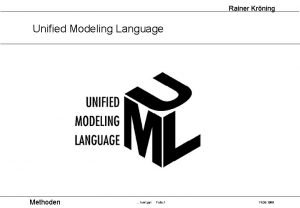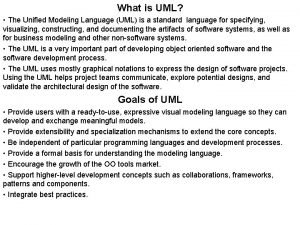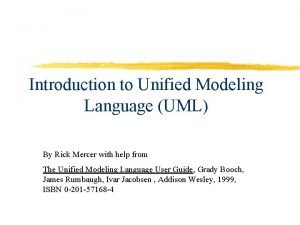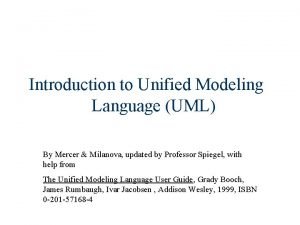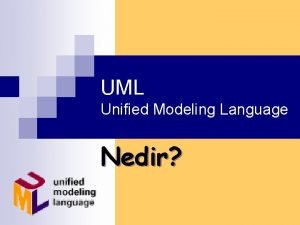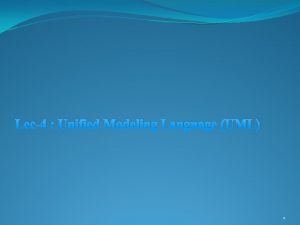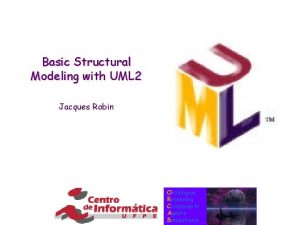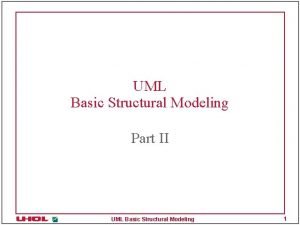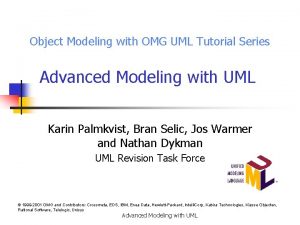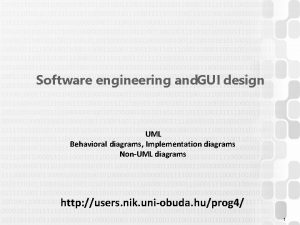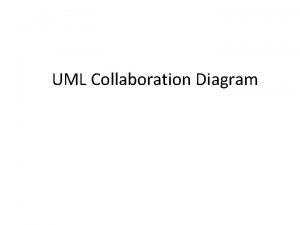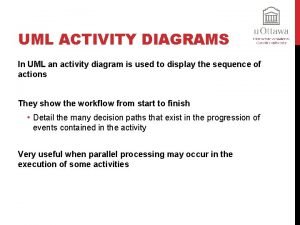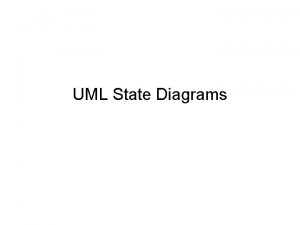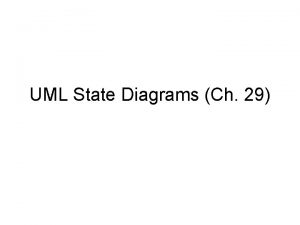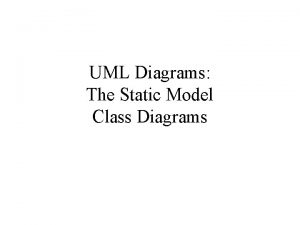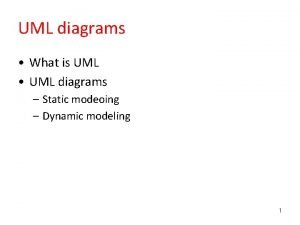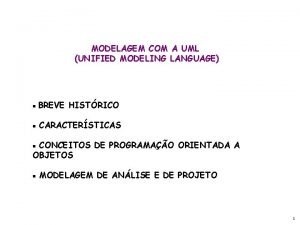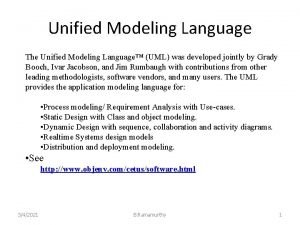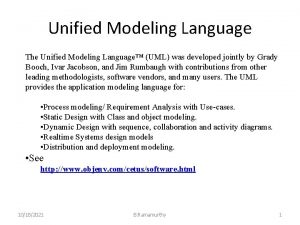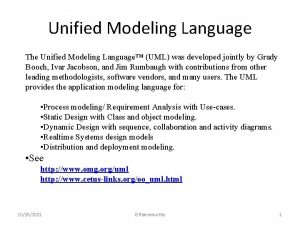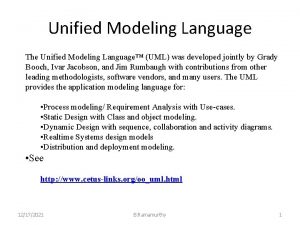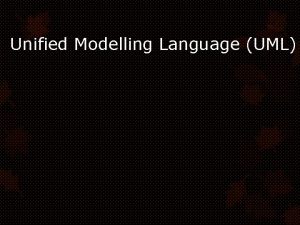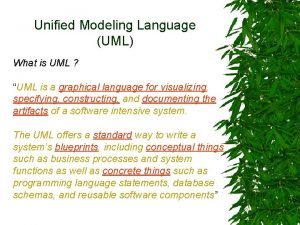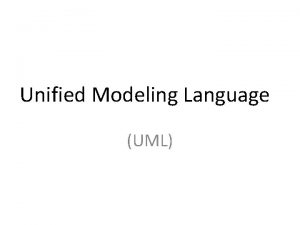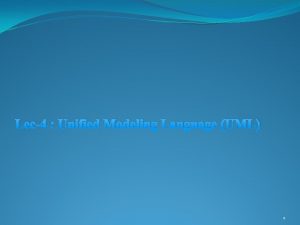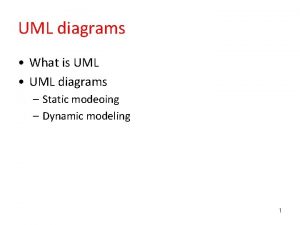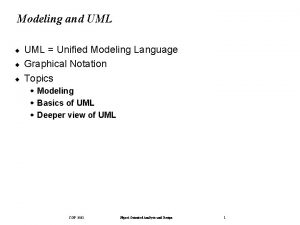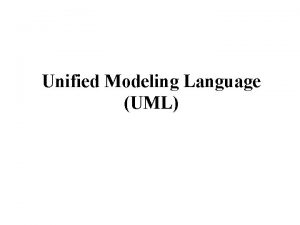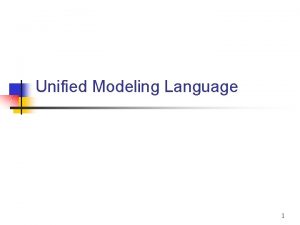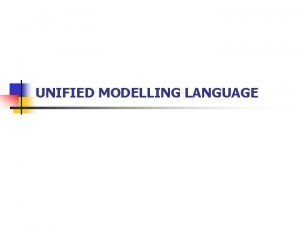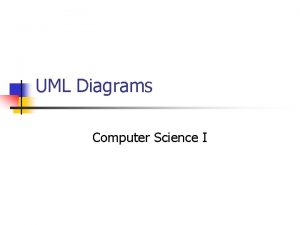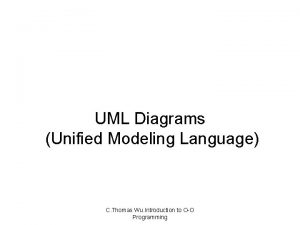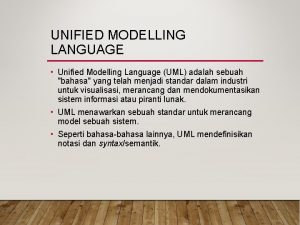UML Diagrams Unified Modeling Language What is UML



































- Slides: 35

UML Diagrams Unified Modeling Language

What is UML? �Standard language for specifying, visualizing, constructing, and documenting the artifacts of software systems, business modeling and other non-software systems. �The UML represents a collection of best engineering practices that have proven successful in the modeling of large and complex systems. �The UML is a very important part of developing object oriented software and the software development process. �The UML uses mostly graphical notations to express the design of software projects. �Using the UML helps project teams communicate, explore potential designs, and validate the architectural design of the software.

Overview of UML Diagrams Structural Behavioral Class diagram Use case diagram Collaboration diagram Component diagram Activity diagram Sequence diagram Deployment diagram State diagram Interaction overview Object diagram Interaction diagram Timing Composite structure diagram Package diagram Interaction

Structural Diagram

Class diagram UML class diagrams show the classes of the system, and the methods and attributes of the classes

Class Diagram

Component diagram UML component diagrams Shows the detail of the components shows the dependencies among software components. (Components – Software entities that satisfy certain function requirements)

Component diagram

Deployment diagram UML deployment diagram Deployment diagrams show the hardware for your system, the software that is installed on that hardware, and the middleware used to connect the disparate machines to one another.

Deployment diagram

Object diagram �UML 2 Object diagrams (instance diagrams), are useful for exploring real world examples of objects and the relationships between them. It shows instances instead of classes. �How objects are related in run-time.

Object diagram

Package diagram �UML 2 Package diagrams simplify complex class diagrams, it can group classes into packages. A package is a collection of logically related UML elements. Packages are depicted as file folders and can be used on any of the UML diagrams.

Package diagram

Composite structure diagram �UML 2 Composite structure diagrams used to explore run-time instances of interconnected instances collaborating over communications links. It shows the collaboration. �Computer object has CPU object, memory object.

Composite structure diagram

Behaviour Diagram

Activity diagram �UML 2 Activity diagrams helps to describe the flow of control of the target system, such as the exploring complex business rules and operations, describing the use case also the business process. It is objectoriented equivalent of flow charts. �A sequence of events in an activity.

Activity diagram

State machine diagram �UML 2 State machine diagrams can show the different states of an entity also how an entity responds to various events by changing from one state to another.

State machine diagram

Use cases diagram UML 2 Use cases diagrams describes the behavior of the target system from an external point of view. Use cases describe "the meat" of the actual requirements. �Use cases. A use case describes a sequence of actions that provide something of measurable value to an actor and is drawn as a horizontal ellipse. �Actors. An actor is a person, organization, or external system that plays a role in one or more interactions with your system. Actors are drawn as stick figures. �Associations. Associations between actors and use cases are indicated by solid lines. An association exists whenever an actor is involved with an interaction described by a use case.

Use cases diagram

Use cases diagram

Interaction Diagram

Collaboration diagram �UML 2 Collaboration diagrams used to model the dynamic behavior of the use case. Diagram is more focused on showing the collaboration of objects.

Communication diagram

Sequence diagram �UML 2 Sequence diagrams models the collaboration of objects based on a time sequence. It shows how the objects interact with others in a particular scenario of a use case.

Sequence diagram

Timing diagram �UML 2 Timing diagrams shows the behavior of the objects in a given period of time. Timing diagram is a special form of a sequence diagram. The differences between timing diagram and sequence diagram are the axes are reversed so that the time are increase from left to right and the lifelines are shown in separate compartments arranged vertically.

Timing diagram

Interaction overview diagram �UML 2 Interaction overview diagrams provides an overview in which the nodes represent communication diagrams. It is a variant of the Activity Diagram where the nodes are the interactions or interaction occurrences.

Interaction overview diagram

UML diagram hierarchy

References �http: //www. agilemodeling. com/ �http: //www. visualparadigm. com/VPGallery/diagrams/index. html �http: //bdn. borland. com/article/0, 1410, 31863, 00. html �http: //en. wikipedia. org/wiki/Unified_Modeling_La nguage �http: //pigseye. kennesaw. edu/~dbraun/csis 4650/ A&D/UML_tutorial/index. htm
 Unified modeling language uml
Unified modeling language uml Unified modeling language tutorial
Unified modeling language tutorial Introduction to the unified modeling language
Introduction to the unified modeling language What is uml
What is uml Pengertian unified modeling language
Pengertian unified modeling language What is uml?
What is uml? Introduction to unified modeling language
Introduction to unified modeling language Mercer oneview login
Mercer oneview login Uml örnekleri
Uml örnekleri Unified modeling language adalah
Unified modeling language adalah Object diagram captures the behavior of a single use case
Object diagram captures the behavior of a single use case Omg unified modeling language
Omg unified modeling language Helen erickson nursing theory
Helen erickson nursing theory Relational modeling vs dimensional modeling
Relational modeling vs dimensional modeling The interaction diagrams, use case diagrams are called as
The interaction diagrams, use case diagrams are called as Activity diagram if
Activity diagram if Why uml is called unified
Why uml is called unified Structural modeling in uml
Structural modeling in uml Common mechanisms in basic structural modeling
Common mechanisms in basic structural modeling Uml modeling tutorial
Uml modeling tutorial Analysis class diagram
Analysis class diagram Uml gui
Uml gui Uml diagram wikipedia
Uml diagram wikipedia Collaboration diagram notations
Collaboration diagram notations Uml activity diagram
Uml activity diagram Gym management system website
Gym management system website Pos uml diagrams
Pos uml diagrams State diagrams uml
State diagrams uml Pos uml diagrams
Pos uml diagrams Hospital reception subsystem use case diagram
Hospital reception subsystem use case diagram Object diagram
Object diagram Class diagram static
Class diagram static Static and dynamic diagrams in uml
Static and dynamic diagrams in uml Things are explanatory parts of uml model
Things are explanatory parts of uml model Uml 0..*
Uml 0..* Unified modelling language
Unified modelling language



